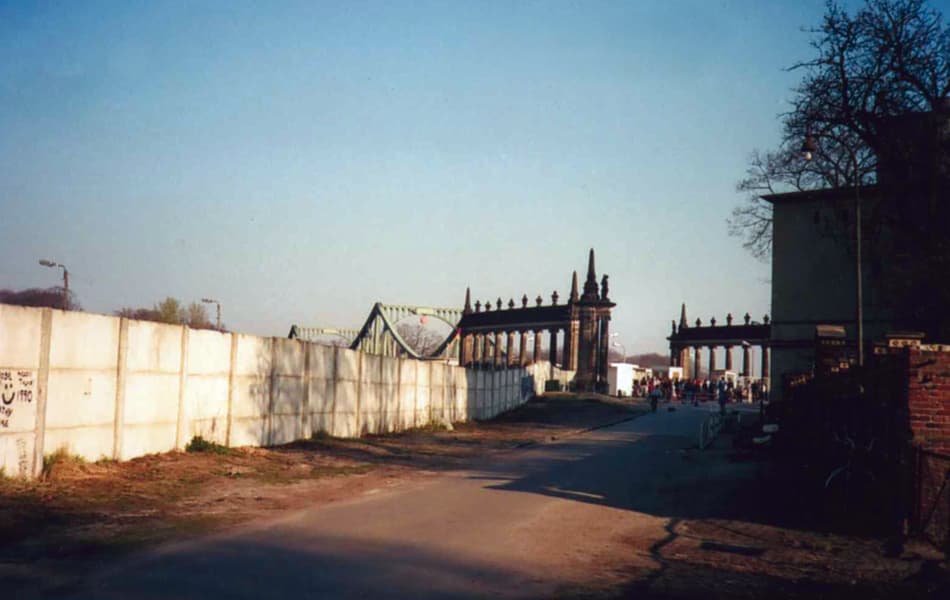About the project
The exhibition
at Jungfernsee lake
 The hinterland wall on Schwanenallee, early 1990 - Photo: Stiftung Berliner Mauer, Ulrich Zimmer
The hinterland wall on Schwanenallee, early 1990 - Photo: Stiftung Berliner Mauer, Ulrich Zimmer
What
In April 2019 the outdoor exhibit in German and English was opened along the former GDR border strip in Potsdam between Glienicke Bridge and Bertinistrasse, the site of a major border checkpoint and clearing station for inland waterway traffic between East and West from 1964 to 1990. The exhibit shows and explains the construction of the frontier barrier with a focus on daily life in the border area. Who was allowed to occupy and use the buildings on the shores of Jungfernsee? What was the policy of the GDR towards the Jewish owners expropriated before 1945, and how did property relations change after unification in 1990?
Why
Nedlitz border crossing, a clearing station for maritime traffic between the GDR and the Federal Republic, was one of the most important East–West waterways. Unlike other maritime crossings, such as Osthafen in Berlin, many of the material relics from the Cold War period have been preserved here. This includes a control tower at Nedlitz maritime border crossing, parts of the pontoon barrier, the generator house, various buildings belonging to the guard units, screening hedges, lamps, concrete slabs and concrete fence posts. These relics need to be preserved and explained to walkers and tourists, because ever since the demolition of the frontier barriers in the early 1990s there is very little left here to remind us of divided Germany. A final piece of the border wall was in fact demolished as late as 2011. This once restricted zone, extending for miles from Glienicke Bridge to the maritime border crossing at Nedlitz, has now become one of the most beautiful outdoor spaces in Potsdam.
Traces of the vanished border have been discovered with the aid of files, maps, photos and conversations with contemporary witnesses. Our exhibit trail, coupled with striking photos, is not only meant to provide background information on the period of communist rule in East Germany, it also endeavors to make accessible to an international audience the meaning of material relics and their context.
When
Brief timeline on the history of the exhibit:
- April 2022: Audioguide based on the exhibition launched by Harry Kühn and the Potsdam Marketing und Service GmbH. You can listen to it here and in the App Potsdam City Guide.
- April 2019: Opening of the information trail in the presence of representatives of the state capital Potsdam, the Prussian Palaces and Gardens Foundation, the Federal Foundation for the Reappraisal of the SED Dictatorship, as well as the Brandenburg Ministry for Science, Research and Culture.
- November 2017: Potsdam City Council decides in favor of creating and implementing the information trail.
- January to December 2017: Creation of the information plaques, location search, development and coordination of pillar design; funding by the Federal Foundation for the Reappraisal of the SED Dictatorship.
- June to November 2016: Scholarly investigation and documentation of the history of the maritime border crossing at Nedlitz as well as the border area north of Glienicke Bridge; funding by the Ministry for Science, Research and Culture of the State of Brandenburg.
- October 2015 to March 2016: Development of a concept for the creation of an information trail for the Potsdam City Council by the Leibniz Centre for Contemporary History Potsdam and the Erinnerungsorte Potsdamer Grenze e.V. society.
- October 2015: Potsdam City Council approves a concept for a memorial site at the Nedlitz border crossing in cooperation with Erinnerungsorte Potsdamer Grenze e.V.
- September 2014: Founding of the Erinnerungsorte Potsdamer Grenze e.V. society.
Who
Project lead: Prof. Dr. Frank Bösch/Dr. Hans-Hermann Hertle, ZZF
and Prof. Jan Fiebelkorn-Drasen, Erinnerungsorte Potsdamer Grenze e.V.
Idea: Erinnerungsorte Potsdamer Grenze e.V.
Concept & editing: Florentine Schmidtmann
Translation: David Burnett
Layout: Soner Ipekcioglu, Die Setzer.
Production: Werbetechnik Zinke GmbH
Coordination for city administration Potsdam: Tobias Büloff, Cultural Department
Leibniz Centre for Contemporary History Potsdam
Leibniz Centre for Contemporary History Potsdam (Leibniz-Zentrum für Zeithistorische Forschung Potsdam, ZZF) studies twentieth-century German and European contemporary history and its impact on the present. The ZZF is a member institution of the Leibniz Association and collaborates with numerous university and non-university research institutes in Germany and abroad. It has ties to the University of Potsdam and Humboldt University in Berlin in the form of joint professorships, and cooperates with a range of other institutes of higher learning in research, instruction, and training a new generation of scholars. In addition to basic research, the core tasks of the ZZF are providing research infrastructure and promoting knowledge transfer. www.zzf-potsdam.de
Erinnerungsorte Potsdamer Grenze e.V.
Erinnerungsorte Potsdamer Grenze e.V. – the Sites of Memory at the Potsdam Border society – was founded in 2014 with the aim of preserving relics of the border crossing and border facilities on the banks of the Havel river and the shores of Jungfernsee lake, thus preserving the memory of the East German border regime. The society aims to
- promote and remember German division,
- research and document the effects of German division,
- research and document the border regime of the Socialist Unity Party (SED), in particular the border crossing point at Nedlitz on Bertinistrasse in Potsdam,
- preserve and maintain the few remaining remnants of the Berlin–Potsdam border facilities,
- establish a history trail along a section of the former Berlin–Potsdam border facilities from Glienicke Bridge (Museum of Divided Germany at Villa Schöningen) to the Potsdam Agreement Memorial Site at Cecilienhof Palace, to the former Nedlitz border crossing at Bertinistrasse.
Contact:
Prof. Jan Fiebelkorn-Drasen
E-Mail: This email address is being protected from spambots. You need JavaScript enabled to view it.
Sources





